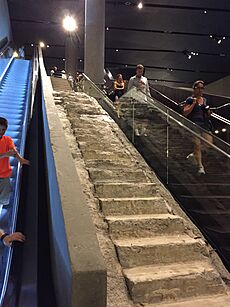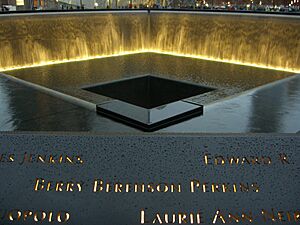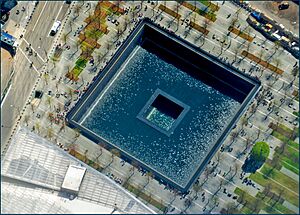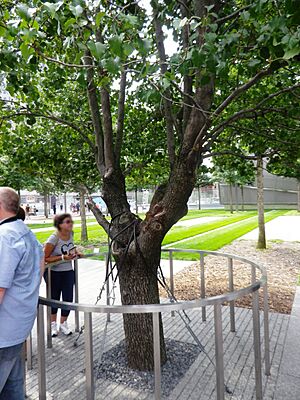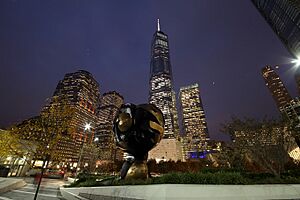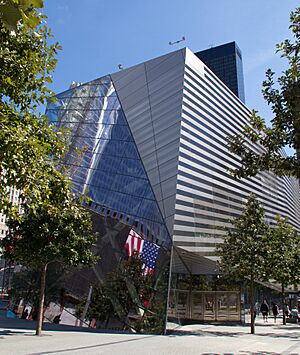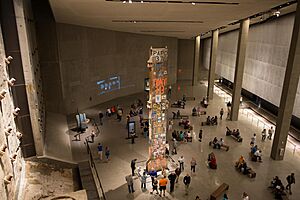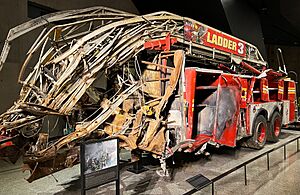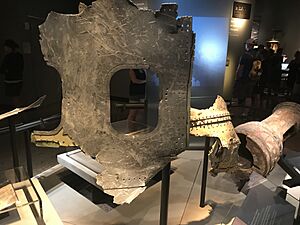- This page was last modified on 17 October 2025, at 10:18. Suggest an edit.
National September 11 Memorial & Museum facts for kids
"9/11 Memorial" redirects here. For other memorials, see Memorials and services for the September 11 attacks.
| National September 11 Memorial & Museum |
|
|---|---|
 |
|

The National September 11 Memorial and Museum in Lower Manhattan
|
|
| General information | |
| Status | Open |
| Type | Memorial and museum |
| Location | 180 Greenwich Street, New York City, NY, 10007, U.S. |
| Coordinates | 40°42′42″N 74°0′49″W / 40.71167°N 74.01361°W |
| Construction started | March 13, 2006 |
| Opening | Memorial: September 11, 2011 (Dedication and victims' families) September 12, 2011 (Public) Museum: May 15, 2014 (Dedication and victims' families) May 21, 2014 (Public) |
| Height | |
| Roof | Memorial: The footprints of the Twin Towers are underground. Museum: Pavilion is from 66 to 75 feet (20 to 23 m) high. |
| Design and construction | |
| Architect | Michael Arad of Handel Architects, Peter Walker and Partners (memorial and landscape design); Davis Brody Bond (museum); Snøhetta, AAI Architects, P.C. (museum entrance pavilion) |
| Engineer | Jaros, Baum & Bolles (MEP) |
| Structural engineer | WSP Global BuroHappold Engineering (Museum) |
The National September 11 Memorial & Museum (also known as the 9/11 Memorial & Museum) is a special place in New York City. It helps us remember the terrible September 11 attacks in 2001, which caused the deaths of 2,977 people. It also remembers the 1993 World Trade Center bombing on February 26, 1993, which killed six people.
This memorial and museum are part of the World Trade Center complex. They are built where the Twin Towers once stood before they were destroyed. A non-profit group runs the memorial and museum. Their job is to raise money and make sure this important place keeps running.
Plans for a memorial started right after the attacks. An architect named Michael Arad won a competition to design it. He worked with a landscape architect, Peter Walker. Together, they designed a peaceful area with many swamp white oak trees. In the center are two large square reflecting pools. These pools mark the exact spots where the Twin Towers used to be.
Construction on the memorial and museum began in August 2006. The memorial was officially opened on September 11, 2011, which was ten years after the attacks. Families of the victims were there for the dedication. The public could visit starting the next day. The museum opened later, on May 21, 2014, after a special dedication ceremony on May 15, 2014.
Contents
Remembering the Past
How the Memorial Was Planned
The National September 11 Memorial & Museum started as a non-profit group. Its main goal was to raise money and manage the building of the memorial. In 2003, a competition was held to find the best design for the memorial. Many people from all over the world sent in their ideas.
On January 6, 2004, the design called Reflecting Absence was chosen. It was created by Michael Arad and Peter Walker. This design features a field of trees and two large, sunken pools. These pools are in the exact shape of the Twin Towers' foundations. The names of all the victims are carved into bronze panels around these waterfalls. The names are placed in a special way, often grouping people who worked together or were near each other during the attacks.
Sharing the Story Across the Country
In September 2007, the Memorial & Museum started a four-month tour across 25 states. This tour helped people learn about the upcoming memorial. Thousands of people took part in the activities. The tour showed photos and items from the attack site. It also included a film with stories from people who were there. Visitors could even sign steel beams that would later be used in the memorial's construction.
How the Memorial Was Built
Construction began on March 13, 2006. Some families of victims wanted the memorial to be above ground, but the chosen design was built below street level. In July 2008, a special piece called the Survivors' Staircase was moved into the museum area. This staircase was used by many people to escape the attacks. It was the first item to be placed in the museum.
By September 2009, the first steel column for the memorial was put in place. Workers installed a total of 9,100 tons of steel. By April 2010, the reflecting pools were framed with steel, and granite was being added. In August, workers started planting trees on the memorial plaza. These are swamp white oak trees, which can grow very tall and live for hundreds of years.
A very special tree, called the "Survivor Tree", was also replanted. This callery pear tree survived the attacks and became a symbol of hope. In September 2010, two large "tridents" from the original Twin Towers were put back at the site.
The North Pool waterfall was tested in November 2010, and the South Pool waterfall in May 2011. Most of the memorial was ready for the 10th anniversary of the attacks. On September 12, 2011, the memorial opened to the public. Over a million people visited in the first three months. The fences around the memorial were removed on May 25, 2014, after nearby construction was finished.
Construction progress
Construction progress (left to right): January 2008, January 2009, July 2010, December 2010, June 2011, August 2011, February 2012
Memorial Design and Features
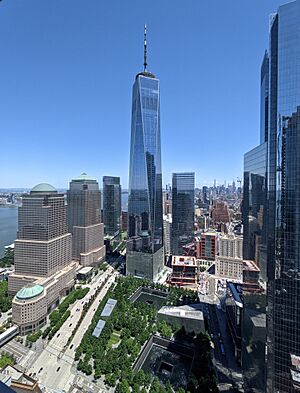
National September 11 Memorial & Museum in the new World Trade Center complex
The Reflecting Absence design was chosen in January 2004. It features two large pools, each about 1 acre in size. These pools have the biggest man-made waterfalls in the United States. They are located exactly where the Twin Towers stood. The waterfalls are meant to make the city sounds quieter, creating a peaceful place for reflection. More than 400 swamp white oak trees surround the plaza, adding to the calm atmosphere.
How Victims' Names Are Arranged
The names of 2,983 victims are carved into 152 bronze panels around the memorial pools. This includes 2,977 people who died in the September 11 attacks and six people who died in the 1993 World Trade Center bombing. The names are arranged in a special way to create "meaningful adjacencies." This means people who were together during the attacks, worked for the same company, or were on the same flight are often listed near each other. Families also made requests for how names should be grouped.
- North Pool: Names of people from the North Tower, passengers and crew of American Airlines Flight 11, and victims of the 1993 bombing.
- South Pool: Names of people from the South Tower, passengers and crew of United Airlines Flight 175, first responders, and passengers and crew of United Airlines Flight 93 and American Airlines Flight 77.
The names of the six adult victims of the 1993 bombing are on Panel N-73 at the North Pool. For ten pregnant women who died on 9/11 and one in the 1993 attack, the words "and her unborn child" follow their names.
The Survivor Tree
A special callery pear tree was found in the rubble of the World Trade Center site in October 2001. It was badly burned and had only one living branch. This tree became known as the "Survivor Tree." It had been planted in the 1970s near the original World Trade Center buildings.
The tree was moved to a nursery in the Bronx for care. Many thought it wouldn't survive, but it began to grow new branches the next spring. The Survivor Tree became a symbol of hope and new beginnings. In March 2010, it was replanted after a storm uprooted it, showing its strength once again.
In December 2010, the 30-foot-tall tree was brought back to the World Trade Center site. It is now a very important part of the memorial plaza. The Survivor Tree reminds everyone of the human spirit's ability to keep going even after terrible events.
Memorial Glade
In May 2018, plans were announced for a path called the "memorial glade" at the memorial. This path honors the first responders who became sick or died after breathing in harmful substances at the World Trade Center site. The glade opened on May 24, 2019. It includes six large, rough stones that look like they were violently moved, showing strength and resistance. Pieces of debris from the original World Trade Center are also placed along the path.
The Sphere Sculpture
The Sphere is a large bronze sculpture by German artist Fritz Koenig. It was made for the old World Trade Center in 1971. The sculpture was damaged during the September 11 attacks but survived. It was moved to Liberty Park, next to the Memorial, in 2017.
The Museum at the September 11 Memorial
The September 11 Museum opened to the public on May 21, 2014. It holds more than 40,000 images, 14,000 items, and thousands of hours of recordings and videos.
Museum History and Collection
The museum is built underground and contains many items from September 11, 2001. These include steel pieces from the Twin Towers, like the "Last Column." This was the final piece of steel to be removed from Ground Zero in May 2002.
Construction of the museum paused for a while due to disagreements over costs. However, work started again on September 10, 2012. The museum was officially opened on May 15, 2014, with many important people attending, including President Barack Obama and former President Bill Clinton. Over 42,000 first responders and families of victims visited the museum during the five days before it opened to the public.
On May 21, 2014, the museum had its public opening ceremony. A restored 30-foot national 9/11 flag was brought into the museum for permanent display. The museum is designed to help people remember the events without causing too much sadness. Counselors were available during the opening because of the large number of visitors.
Museum Design and Artifacts
The museum was designed by Davis Brody Bond. It is about 70 feet below ground. You enter through a special building designed by Snøhetta. This entrance building looks like a partially collapsed structure, reminding visitors of the attacks. It also holds two "tridents" from the Twin Towers.
One of the museum's walls is part of the original slurry wall. This wall held back the Hudson River and stayed strong during the attacks. The museum also displays damaged emergency vehicles, metal pieces from all seven World Trade Center buildings, and recordings from survivors and first responders. There are also pictures of all the victims and other media showing the destruction.
The museum aims to help people understand what happened on 9/11. It shows the disbelief and sadness felt by New York and the entire country.
Other Memorials
Many other memorials have been built across the United States to remember 9/11. Communities often use pieces of steel from the Twin Towers, which were given out by the Port Authority of New York and New Jersey. Over 1,000 pieces of World Trade Center steel have been shared for these memorials.
See also
 In Spanish: National September 11 Memorial & Museum para niños
In Spanish: National September 11 Memorial & Museum para niños
- List of national memorials of the United States
- Memorials and services for the September 11 attacks
- Casualties of the September 11 attacks

